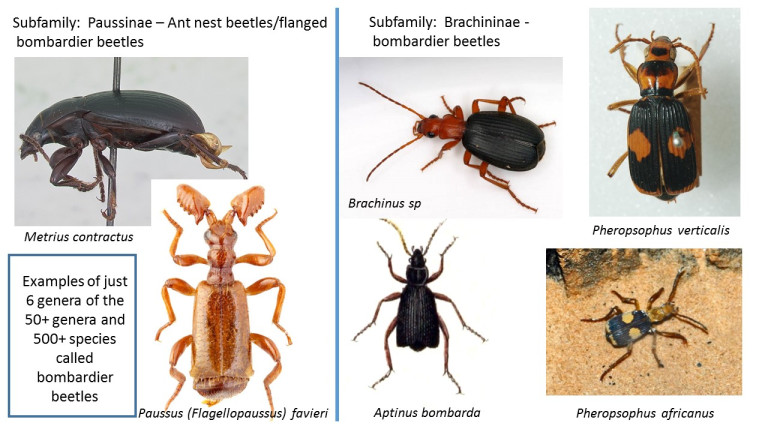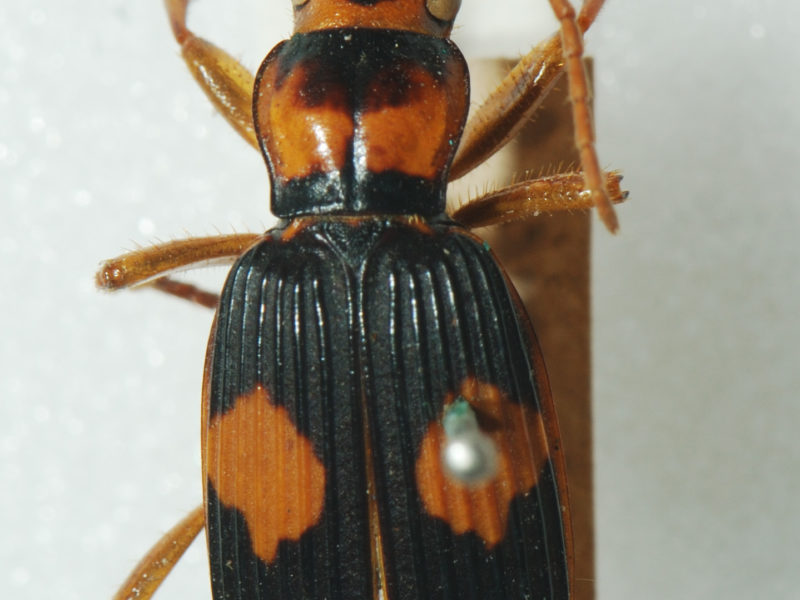Theistic evolutionist Joel Duff has been getting a reputation as an expert critic of creation biology. His latest blog post is about ground beetles, and specifically bombardier beetles. I don’t normally spend a lot of time on this kind of thing, but it’s on my mind currently because I’ve been preparing some kind of response to Duff’s recent critique of creationist views about speciation in the journal ‘Evolution: Education and Outreach’.
The views expressed in this article reflect those of the author mentioned, and not necessarily those of New Creation.
In short, his latest post points out that there are hundreds of bombardier beetle species, not all equipped with the same set of traits, and they’re distributed across several subfamilies within the ground beetle family (Carabidae). This means that bombardiers are more closely related to non-bombardiers within their own subfamily than they are to bombardiers in other subfamilies (i.e. bombardiers don’t form a monophyletic group).

Montage Credit: Joel Duff
Duff suggests that these observations are devastating to creationist design arguments based on the supposed “irreducible complexity” of the bombardier beetle’s chemical defense system. He points out that if created kinds approximate biological families (as creationists suggest) then bombardiers must share a common ancestor with non-bombardiers, and this weakens the force of the irreducible complexity claim.
Moreover, the bombardier “design” must have arisen multiple times within the ground beetle family within a very short time frame, and this amounts to hyper-evolution beyond anything claimed in standard evolutionary theory.
I think this captures the essence of his argument. So how to respond? Here are a few initial thoughts.
First, I’m not aware that any statistical baraminology studies of the Carabidae have been done. And I think we should be cautious about assuming that the created kind in insects and other invertebrates approximates the family, just because that seems to be the case in vertebrates. Maybe yes; maybe no. This probably doesn’t affect the core of Duff’s argument, because even if the ground beetle kinds turned out to be subfamilies we still have bombardier and non-bombardier forms in a single kind. But we do need actual studies to move beyond speculation.
Second, the observations Duff makes conflict only with a certain type of design argument – one that was admittedly popular with previous generations of creationists. This design argument assumes that the bombardier beetle was directly created by God in essentially its present form, with all the elements of its complex chemical defence system already present. Duff is right to point out that this kind of argument conflicts with the findings of modern baraminology, which suggest that bombardiers and non-bombardiers are variant forms within a single created kind. Perhaps that’s a revelation to lay people, but it’s hardly a new idea to creation biologists, who have been talking about this stuff for quite a while.

As an example, Todd Wood has been writing about what he calls mediated design since at least 2003. (There’s a lengthy discourse on the topic in Wood and Murray’s textbook, ‘Understanding the Pattern of Life’, published by Broadman and Holman.) Mediated design is where “God creates a genetic potential for a complicated trait that is only accessed at some point in history after Creation. Some species in the baramin access the trait, while others do not. In the same way, some people use the corkscrew in their Swiss army knives, while others do not.” (ICR Impact Article #363; https://www.icr.org/i/pdf/imp/imp-363.pdf). In the Impact article, a few examples are described, including plant baramins encompassing both C3- and C4-photosynthesising species. In 2014, I wrote a paper on woodpeckers (another old creationist standby) and pointed out that, since all members of the woodpecker family appear to belong to a single kind, but not all members possess the full range of “typical” woodpecker traits, that at least some of those traits must have arisen by mediated design. See https://www.coresci.org/jcts/index.php/jctsb/article/view/24
Third, what about the fact that bombardier-type ground beetles must have arisen multiple times within a short time frame? Is that a problem for creationism? Well, yes, if you assume that standard mechanisms such as natural selection were responsible. But not if designed mechanisms are at work, because they have the potential to explain much more rapid genomic and phenotypic change (see Todd Wood’s Altruistic Genetic Elements model, for example). Indeed, designed mechanisms (e.g. the activity of transposons), may well provide a more parsimonious explanation for the multiple emergence of the same trait(s) than the conventional evolutionary model which has to rely on random mutations and selection to explain such convergences. (In their textbook, Wood and Murray make a similar point with respect to the sabre-tooth trait, which seems to have emerged several times during the diversification of carnivores after the Flood.)
Far from being “devastating”, I find this all immensely interesting and exciting. Yes, baraminology means we have to rethink some naïve assumptions of the past, but it provides us with something much better – a fruitful research programme that allows us to propose and test hypotheses about design, diversification and more besides in a way that creationists were never able to do before.
So that leaves one last question … who’s up for carabid baraminology?












Just wanted to thank Paul for his review of my article. He indeed has pointed out that there are other creationist’ approaches to the problem of these beetles that I did not address. This is a good primer on why any taxonomic/baraminic study is often more complex than what are frequently our generalizations for the general public.
Considering that maybe the genetics started with all traits then through natural selection the particular traits won out in one place while others lost the genetic information?
[…] Ten tweede zien de meeste creationisten het defensiesysteem van de bombardeerkever als een verschijnsel van ‘Intelligent Design’. Een dergelijk complex ontworpen mechanisme zou een aanwijzing zijn dat deze door God geschapen is. Dr. Andy McIntosh heeft hier veel onderzoek naar gedaan.5 In ieder geval zou de aanleg voor een dergelijk complex mechanisme al in het bouwplan aanwezig zijn geweest en snel geactiveerd kunnen worden. Helaas is er nog geen uitgebreide baraminologische studie gedaan naar deze groep kevers. Bioloog en theïstisch evolutionist dr. Joel Duff heeft onlangs een kritiek op de creationistische benadering van de bombardeerkever gepubliceerd.6 Paul Garner heeft hier op het blog ‘New Creation’ op gereageerd. Het loont de moeite zijn bijdrage te lezen.7 […]
beetles are awesome
the genetic code does seem a likely storehouse for answers. maybe gene such and such finally turns on for some reason and only THEN can three other genes summate as well.
everything is fearfully and wonderfully made